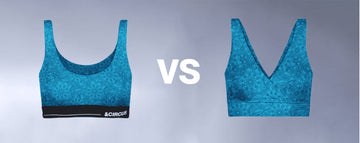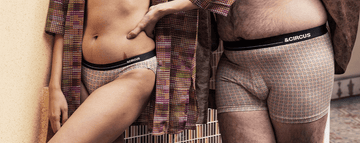The fashion industry has historically perpetuated restrictive ideals of beauty, but a profound transformation is underway. On Instagram, a platform teeming with daily scrolls from millions of users, a fresh storyline is emerging one that celebrates inclusivity, diversity, and genuine self-expression. Campaigns spotlighting plus-size apparel and advocates for eco-friendly styles are turning Instagram into a pivotal arena for redefining consumer perceptions of fashion. This evolution transcends mere visuals; it represents a societal pivot, propelled by influencers, brands, and ordinary individuals who are redefining style norms.
Uncomfortable underwear shouldn't steal your confidence. At Andcircus, we craft ultra-soft, sustainable Lenzing Modal Micro® innerwear for every body, XS to 5XL. From briefs to bras, our custom packs fit you perfectly. Shop risk-free with our 100% satisfaction guarantee and embrace comfort that includes everyone. #LoveEveryBody. Shop Now!
The Emergence of Inclusive Fashion on Instagram
Instagram's image-centric nature has positioned it as an ideal venue for fashion, though its emphasis on inclusivity is a more recent development. A comprehensive multi-country longitudinal study covering over ten years and examining more than one million posts from 400 influencers in the United States, Brazil, the Netherlands, and Germany illustrates the role of these creators in fostering change. The research uncovers variations in the maturation of content monetization across nations, alongside uniform trends; notable disparities in posting rates but comparable patterns in user interaction; and marked differences in sponsored content transparency in certain regions, tied directly to local laws.
Researchers examined adaptations in promotional tactics prompted by regulatory and platform updates, emphasizing how influencers adjust disclosure techniques to comply with varying legal frameworks. They also assessed the effects of disclosures and paid promotions on interaction levels, finding that while paid content typically garners less engagement, transparent ad labeling does not diminish it additionally. These insights underscore the critical need for adherence to disclosure standards and could inform policymakers in crafting and overseeing them more efficiently.
This surge is driven by consumer insistence. The worldwide plus-size clothing market was valued at USD 311.44 billion in 2023 and is expected to expand to USD 412.39 billion by 2030, advancing at a compound annual growth rate of 4.1% from 2024 onward. The sector is witnessing a notable uptick in buyer expenditures. North America held a commanding 43.97% of the revenue in 2023. Within that, the U.S. plus-size segment captured 82% of North America's share. Women dominated with a 52.20% revenue portion, while the under-15 age bracket surprisingly led with 14.5%. Such figures demonstrate that inclusivity is no longer marginal it's a burgeoning force, amplified by Instagram.
Brands are responding by collaborating with diverse influencers, leveraging the platform's vast audience to mainstream varied representations. This strategic shift not only broadens market reach but also fosters a sense of belonging among consumers previously sidelined by traditional fashion narratives.
The Influence of Genuine Connections in Campaigns
Influencers form the core of Instagram's fashion landscape. Contrasting with conventional ads featuring idealized figures, influencers offer a personal flair. They narrate individual experiences, display authentic physiques, and interact straightforwardly with audiences. However, this extends beyond mere connection it's tactical. The aforementioned study revealed that sponsored entries often receive reduced engagement compared to unpaid ones, yet forthright ad revelations do not erode interest further. Indeed, openness cultivates reliability. In nations such as Germany and the Netherlands, with rigorous rules requiring explicit sponsored tags, influencers have innovated, integrating notices fluidly without alienating viewers.
Consider Brazil's dynamic scene, where content is lively and abundant. Influencers there outpace U.S. peers in posting volume, but engagement dynamics hold steady internationally. The reason? Genuineness strikes a chord. An influencer's share of a plus-size collection, personalized in styling, transcends product promotion it's a declaration. Audiences connect with this unfiltered sincerity, be it an American promoter of body acceptance or a German navigator of compliance mandates. This interplay compels brands to overhaul strategies, shifting from uniform promotions to alliances that exude authenticity.
Moreover, the professionalization of monetization varies, with some countries showing more structured approaches. Yet, consistent engagement trends suggest that cultural barriers do not hinder the universal appeal of transparent, relatable content. Brands harnessing this can build lasting loyalty, turning one-time viewers into advocates.
Pairing Sustainability with Inclusivity
Inclusive fashion extends beyond physical variety; it encompasses principles too. Eco-conscious apparel, emphasizing moral manufacturing and ecological stewardship, is rising in tandem with inclusive initiatives. A recent Gen Z consumer study explores how brand-created and user-created content affect buying intents in sustainable fashion, mediated by social media interaction. Employing a quantitative method, the research used layered random selection for Gen Z individuals aged 16 to 28. Information from 643 participants was gathered via organized questionnaires and evaluated with Partial Least Squares Structural Equation Modeling in SmartPLS.
Social media interaction partly bridges these links, enhancing the effects of both content forms on buying actions. Diverging from prior works examining brand or user content separately, this investigation probes their interaction and the pivotal bridging function of engagement. The ascent of eco-friendly fashion signifies an increasing commitment to ecological and moral issues.
The study, focusing on platforms like Instagram and TikTok, found brand-generated content exerts a stronger direct impact on purchase intentions than user-generated, but both are amplified through engagement metrics like likes and shares. This mediation strengthens the bond between messaging and action, particularly for sustainable, size-diverse lines.
This fusion is potent. Sustainable practices tackle moral dilemmas, while inclusivity addresses visibility. Combined, they craft a persuasive tale appealing to youth, who favor value-aligned brands. Instagram's system boosts interactive content, propelling it further. A lone entry featuring an eco-plus outfit can motivate masses, elevating a targeted effort to a societal wave.
Brands can capitalize by blending content types official posts for credibility, user shares for trust fostering deeper engagement and driving ethical purchases.
Navigating Regulations: Hurdles and Prospects
Progress isn't without obstacles. The extended research indicates that domestic laws mold sponsored disclosure, yielding diverse approaches. In stringent Germany, clear ad markings are obligatory, potentially cumbersome. Brazil's laxer framework permits creativity but risks opacity. These variances pose difficulties for international brands in sustaining unified messaging amid legal variances. Nonetheless, they offer chances. Entities mastering equilibrium merging adherence with captivating narratives distinguish themselves.
For users, this yields a clearer Instagram realm. A disclosed plus-size collaboration isn't mere compliance; it's trust-building. Trust fuels participation. Evidence supports: paid posts might attract fewer reactions, but honest labels don't compound the drop. This implies honesty is prized alongside diversity.
Further, shifts in laws and features prompt strategic pivots. Influencers in regulated zones innovate disclosure, like creative captions or visuals, maintaining appeal. Brands observing these can refine global tactics, ensuring compliance boosts rather than hinders reach.
Insights from Recent Market Analyses
Complementing these studies, a fresh market report from August 2025 by Avinash Singh and Sunita Singh provides updated perspectives on the plus-size sector. While aligning with broader trends, it reinforces the growth trajectory, highlighting body positivity's role in expanding demand.
Wrapping Up: Fashion's Evolving Horizon
Instagram transcends selfie-sharing it's a forum reshaping fashion. From the plus-size market's robust expansion to burgeoning sustainable-inclusive drives, the app molds self-perception and attire choices. Influencers, fortified by genuineness and data, spearhead this, converting updates into declarations on variety and morals. As entities adjust to regulations and demands, the takeaway is evident: inclusivity is enduring. Next Instagram browse, scrutinize deeply. That inclusive gown or green brand post isn't mere feed it's transformation, interaction by interaction.
Frequently Asked Questions
How has Instagram influenced the growth of plus-size fashion?
Instagram has become a pivotal platform for redefining fashion inclusivity, with campaigns spotlighting plus-size apparel reaching millions of daily users. The global plus-size clothing market, valued at $311.44 billion in 2023, is expected to grow to $412.39 billion by 2030, driven largely by social media representation. Brands are strategically collaborating with diverse influencers on Instagram to mainstream varied body representations and foster belonging among consumers previously marginalized by traditional fashion narratives.
Do sponsored posts on Instagram perform worse than organic content for inclusive fashion brands?
While sponsored posts typically receive less engagement than unpaid content, transparent ad labeling doesn't further diminish interaction rates according to recent research. The key lies in authenticity influencers who share genuine experiences with plus-size collections and maintain transparent disclosure practices build trust with their audiences. Countries with stricter advertising regulations like Germany and the Netherlands have shown that clear sponsored tags, when integrated creatively, can maintain audience engagement while ensuring compliance.
How do sustainable fashion and inclusive fashion work together on social media?
Sustainable and inclusive fashion create a powerful combination on platforms like Instagram, appealing especially to Gen Z consumers who prefer value-aligned brands. Recent studies show that both brand-generated and user-generated content about eco-friendly, size-diverse fashion lines drive purchase intentions when amplified through social media engagement like likes and shares. This fusion addresses both ethical manufacturing concerns and body representation, with a single post featuring an eco-plus outfit capable of inspiring widespread social change beyond just product promotion.
Disclaimer: The above helpful resources content contains personal opinions and experiences. The information provided is for general knowledge and does not constitute professional advice.
You may also be interested in: How Body-Positive Innerwear Campaigns Resonate With Gen Z
Uncomfortable underwear shouldn't steal your confidence. At Andcircus, we craft ultra-soft, sustainable Lenzing Micro Modal innerwear for every body, XS to 5XL. From briefs to bras, our custom packs fit you perfectly. Shop risk-free with our 100% satisfaction guarantee and embrace comfort that includes everyone. #LoveEveryBody. Shop Now!







































